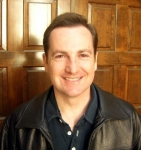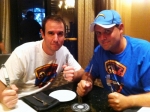2. Linking merchandise to the interactive elements

Nick Sim, Theme Park Tourist editor-in-chief:
Although the original Wizarding World of Harry Potter was incredibly impressive in terms of its overall theming and the attractions within it, its real legacy was the impact it had on the role of food and merchandise as part of a themed experience.
It's no longer enough just to tack a store stocked with some generic items onto the end of an attraction – the stores, restaurants, and even the items that they sell have got to be a part of the story, too. Critically, not only does that make the experience better for guests, it also dramatically increases sales.
It's no secret that Disney, SeaWorld, and others have been looking on enviously at Universal's success, and we've already seen attempts to copy it with the likes of LeFou's Brew at Gaston's Tavern in the Magic Kingdom. Universal, too, has clearly decided that fully immersive areas with associated food, beverages, and souvenirs are the way to go.
I think we're witnessing the end of its movie studio-themed parks (with bland soundstages facades, etc.) – we've already got Springfield at Universal Studios Florida, and Universal Studios Hollywood is heading in that direction with its three new lands (the Wizarding World clone, Springfield clone, and Super Silly Fun Land).
So what of Diagon Alley? Well, if Robert's information is to be believed (and let's be honest – it always is), then we'll see Universal pushing things forward again in this area. Tying the merchandise to actual interactive elements within the land is only going to increase sales further, and I'm sure that will (at least eventually) extend to requiring guests to buy multiple wands to experience every special effect, for example.
Disney, in theory, is in a position to take this even further with personalized experiences, given that it's rolled out RFID just about everywhere. As Seth says, though, it will be interesting to see how both companies handle such personalized experiences in the face of massive crowds. People are willing to wait in line for a ride or even a store (Ollivander’s), but will they really queue up to cast a spell? We'll have to wait and see.
One other thing. The Wizarding World and Springfield work so well because they are based on "universes" that we all recognize from hugely popular movie/television franchises. Would they be anywhere near as successful in terms of merchandise sales if they were based on original IPs?
I doubt it – and that will probably reinforce the trend away from attractions based on original IPs that we're already seeing at Disney.
3. Engaging all five senses – even more

Robert Niles, Theme Park Insider editor-in-chief:
First, thank you to everyone on the compliments for our reporting on Diagon Alley. It's been a pleasure for me as a fan to follow this development from its beginning, and bringing it to others as a publisher has given me an extra thrill. I can't wait to actually visit this place I've been describing online for so long!
As for its legacy and impact? Diagon Alley represents the next step in the transformation of theme parks from collections of attractions to a platform for immersive entertainment.
The original Wizarding World probably has been the most cosplayed theme park attraction in the world. I've never visited when I didn't see at least one other visitor in Hogwarts robes, fully immersed in the experience of living in Hogsmeade.
Diagon Alley promises to take that level of immersion to a deeper level, with the introduction of interactive magic wands and a fully-contained themed experience. Universal's Wizarding World might have been the first theme park development to utilize all five senses in creating an immersive environment, by adding taste to the mix with Butterbeer, Chocolate Frogs, and other treats first described and depicted in the Harry Potter books and films. Few entertainment franchises create the opportunity for the inclusion of food in the experience, but Potter did, and Universal took advantage.
Diagon Alley will continue and extend that five-sense immersion, but in a project that Universal developed from scratch, as opposed to one built on top of an existing development, as Hogsmeade was built atop the remnants of Islands of Adventure's Lost Continent. There won't be rollercoasters with half-developed themes in Diagon Alley; it promises to be a completely authentic recreation of the Diagon Alley experience suggested in the books and films.
By creating that, Universal sets a new standard for themed entertainment, one that Disney will need to match with Avatar and Star Wars so as not to look like it’s fallen behind its rival in the creative leadership of the industry.
Again, I can't wait to visit this, and all the Wizarding Worlds around the world, including those under construction and those yet to come. ;^)
4. The artist is now front and center, not the execs

Derek Burgan, writer at Touring Plans:
Theme parks seem to be following a trend that Hollywood has been gravitating towards (sequels or properties based on established brands), rather than the cable TV model of fresh and unique voices (Game of Thrones, Breaking Bad, Newsroom, True Detective, Orange Is the New Black, etc.). Part of this is who has the power; in Hollywood, it is often in the hands of the directors, whereas TV has that power with the writers and showrunners.
You could definitely make a case that Disney’s theme park division is dealing with all the trappings of a major Hollywood studio. The amount of bureaucracy and “hands in the pie” are forcing them to turn towards brands that are already established, partly because those making the decisions aren’t creative.
Meanwhile, Universal is in bed with the creative talent and putting themselves solely at the creator’s whims, which can cause things like Chief Wiggum’s police car having to be repainted because Matt Groening didn’t approve.
With the amount of money at stake (even the low end of the first Wizarding World budget was $300 million – at the time for Universal, a huge number), it’s easy to see why all these companies want to go as safe as possible, but I think that the first WWOHP changed the game for what we considered immersion. It’s now expected in everything.
Disney’s New Fantasyland is light-years ahead of anything else they have had in Magic Kingdom it terms of overall look. SeaWorld’s Antarctica: Empire of the Penguin was a whole new direction for them, and Cabana Bay Beach Resort takes the theme park value resort model (that we’ve seen at places like Disney’s All-Star Movies) and turns that dial up to an “11.”
While we look at Diagon Alley as being the next “game changer” in immersion, it’s easy to overlook that the game has already changed. Everything since WWOHP has followed in its footsteps, and the landscape looks to continue that way with Disney Springs and Avatarland in Animal Kingdom.
For a full rundown on Diagon Alley, please see our Complete Guide.
Add new comment